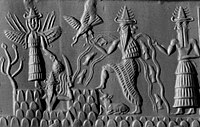Ninlil
This article includes a list of references, but its sources remain unclear because it has insufficient inline citations. (May 2016) (Learn how and when to remove this template message) |

(c. 2094–2047 BCE)
NIN-a-ni....................... "his Lady,"
DSHUL-GI.................... "Shulgi"
NITAH KALAG ga........ "the mighty man"
LUGAL URIM KI ma..... "King of Ur"
LUGAL kien-................. "King of Sumer"
gi kiURIke..................... "and Akkad,"
nam-ti-la-ni-sze3........... "for his life"
a mu-na-ru................... "dedicated (this)"
In Sumerian religion, Ninlil (𒀭𒊩𒌆𒆤 DNIN.LÍL "lady of the open field" or "Lady of the Wind"), also called Sud, in Assyrian called Mulliltu, is the consort goddess of Enlil. Her parentage is variously described. Most commonly she is called the daughter of Nunbarsegunu (or Ninshebargunnu (a goddess of barley) or Nisaba) and Haia (god of stores). Another Akkadian source says she is the daughter of Antu (Sumerian Ki) and Anu (a.k.a. An). Other sources call her a daughter of Anu and his mother, Nammu.
She lived in Dilmun with her family. Impregnated by her husband Enlil, who lie with her by the water, she conceived a boy, Nanna/Suen, the future moon god. As punishment Enlil was dispatched to the underworld kingdom of Ereshkigal, where Ninlil joined him. Enlil impregnated her disguised as the gatekeeper, where upon she gave birth to their son Nergal, god of death. In a similar manner she conceived the underworld god Ninazu when Enlil impregnated her disguised as the man of the river of the nether world, a man-devouring river. Later Enlil disguised himself as the man of the boat, impregnating her with a fourth deity Enbilulu, god of rivers and canals. All of these act as substitutes for Nanna/Suen to ascend.[6] In some texts Ninlil is also the mother of Ninurta, the heroic god who slew Asag the demon with his mace, Sharur.
When Sud gets the name of Ninlil, wife of Enlil[edit]
In the sleeping quarters, in the flowered bed fragrant like a cedar forest, Enlil made love to his wife and took great pleasure in it. He sat her on his dais appropriate to the status of Enlil, and made the people pray to her. The lord whose statements are powerful also determined a fate for the Lady (Aruru), the woman of his favour; he gave her the name Nintur, the 'Lady who gives birth', the 'Lady who spreads her knees'. (...) Proud woman, surpassing the mountains! You who always fulfil your desires—from now on, Sud, Enlil is the king and Ninlil is the queen. The goddess without name has a famous name now… [7]
Family Tree[edit]
| An | |||||||||||||||||||||||||||||||||||||||||||||||||||||||||||||||||||
| Ninḫursaĝ | Enki born to Namma | Ninkikurga born to Namma | Nisaba born to Uraš | Ḫaya | |||||||||||||||||||||||||||||||||||||||||||||||||||||||||||||||
| Ninsar | Ninlil | Enlil | |||||||||||||||||||||||||||||||||||||||||||||||||||||||||||||||||
| Ninkurra | Ningal maybe daughter of Enlil | Nanna | Nergal maybe son of Enki | Ninurta maybe born to Ninḫursaĝ | Baba born to Uraš | ||||||||||||||||||||||||||||||||||||||||||||||||||||||||||||||
| Uttu | Inanna possibly also the daughter of Enki, of Enlil, or of An | Dumuzid maybe son of Enki | Utu | Ninkigal married Nergal | |||||||||||||||||||||||||||||||||||||||||||||||||||||||||||||||
| Meškiaĝĝašer | Lugalbanda | Ninsumun | |||||||||||||||||||||||||||||||||||||||||||||||||||||||||||||||||
| Enmerkar | Gilgāmeš | ||||||||||||||||||||||||||||||||||||||||||||||||||||||||||||||||||
| Urnungal | |||||||||||||||||||||||||||||||||||||||||||||||||||||||||||||||||||
Notes and references[edit]
| Part of a series on |
| Ancient Mesopotamian religion |
|---|
|
Seven gods who decree
|
|
Other major deities |
|
Demigods and heroes
|
| Related topics |
Notes[edit]
- Michael Jordan, Encyclopedia of Gods, Kyle Cathie Limited, 2002.
References[edit]
- ^ (RIME 3/2, p. 161-162)
- ^ "DINGIR.NIN.LILA / NIN-A-NI / DINGIR.SHUL.GI / NITA-KALAG.GA / LUGAL URI/ .KI-MA / LUGAL.KI.EN / GI KI-URI3.KI / NAM.TI.LA NI.SHE3/ A MU.NA.RU." Inscription Translation: "To Ninlil, his lady, Shulgi, mighty man, King of Ur, King of Sumer and Akkad, has dedicated (this stone) for the sake of his life." "cylinder seal / bead". British Museum.
- ^ "CDLI-Archival View". cdli.ucla.edu.
- ^ Sb 6627 Potts, Professor Daniel T. (1999). The Archaeology of Elam: Formation and Transformation of an Ancient Iranian State. Cambridge University Press. p. xiv. ISBN 978-0-521-56496-0.
- ^ Art of the First Cities: The Third Millennium B.C. from the Mediterranean to the Indus. Metropolitan Museum of Art. 2003. p. 243. ISBN 978-1-58839-043-1.
- ^ "Enlil and Ninlil: translation". Faculty of Oriental Studies, University of Oxford.
- ^ "The Electronic Text Corpus of Sumerian Literature". Faculty of Oriental Studies, University of Oxford.
External links[edit]
| Wikiquote has quotations related to: Ninlil |
| Wikimedia Commons has media related to Ninlil. |
| Look up Ninlil in Wiktionary, the free dictionary. |



